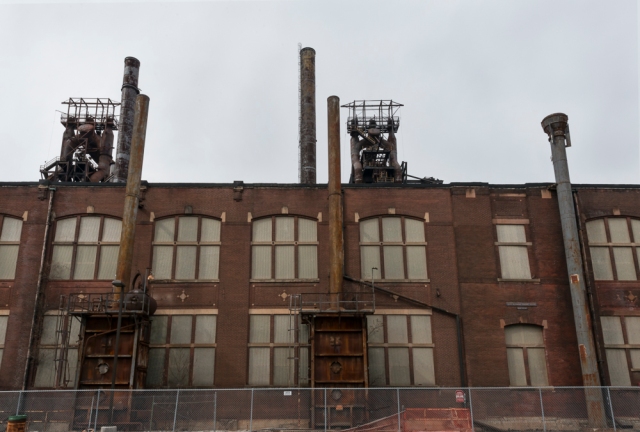This is a continuation of this post.
The second location I photographed was on the grounds of the former DeJarnette Sanitarium, the children’s ward of the Western Lunatic Asylum in Staunton, VA. Admittedly, I do not know the exact purpose of this building. I made the mistake of researching DeJarnette before going and so was scared that I fled after less than an hour there. It isn’t even fenced in, unlike the main grounds of the old hospital, though it is boarded up and covered with asbestos warnings. I could have ventured inside via an open window but, uh, I decided against it.
Western Lunatic Asylum opened in July 1828. Lush gardens and fountains provided a peaceful healing atmosphere for the patients there in its early years. This model of mental health care was completely gone by the middle of the century. Overcrowding led to patients being crammed in rooms similar to solitary confinement chambers in prisons. Administrators used handcuffs, physical coercion and straight jackets to subdue patients. In 1924 the Eugenical Sterilization Act and Racial Integrity Act (yes, it was seriously called that) passed in Virginia, which lead to the involuntary sterilization of anyone declared “undesirable,” including the “syphilitic, epileptic, imbeciles, drunkards, promiscuous, and the poor.” Due to the Racial Integrity Act the majority of those sterilized were black, Native American, or just “one drop” of either. It also “cured” people of sexual traits like masturbation. Some sterilizations were done during other medical procedures (like standard procedures…and electroshock therapy or lobotomy) without the patient’s knowledge. Similar laws were passed in 33 states overall. Public opinion about compulsory sterilization changed during World War II because of its similarity to Nazi genocidal programs. Before it became illegal (state by state) in and around the 1950’s , about 65,000 people were sterilized, though estimates are iffy at best.
Enter onto the scene Joseph DeJarnette, whose testimony lead to the Sterilization Act to be declared constitutional by the Supreme Court in 1927. He was the director of Western State between 1905 and 1943. I could go on about this hideous pile of human scum for quite awhile. Instead I will leave you with his poem, Mendel’s Law: A Plea for a Better Race of Men.
Oh, why are you men so foolish —
You breeders who breed our men
Let the fools, the weaklings and crazy
Keep breeding and breeding again?
The criminal, deformed, and the misfit,
Dependent, diseased, and the rest —
As we breed the human family
The worst is as good as the best.
Go to the house of some farmer,
Look through his barns and sheds,
Look at his horses and cattle,
Even his hogs are thorough breds;
Then look at his stamp on his children,
Low browed with the monkey jaw,
Ape handed, and silly, and foolish —
Bred true to Mendel’s law.
Go to some homes in the village,
Look at the garden beds,
The cabbage, the lettuce and turnips,
Even the beets are thoroughbreds;
Then look at the many children
With hands like the monkey’s paw,
Bowlegged, flat headed, and foolish —
Bred true to Mendel’s law.
This is the law of Mendel,
And often he makes it plain,
Defectives will breed defectives
And the insane breed insane.
Oh, why do we allow these people
To breed back to the monkey’s nest,
To increase our country’s burdens
When we should only breed the best?
Oh, you wise men take up the burden,
And make this you loudest creed,
Sterilize the misfits promptly —
All not fit to breed!
Then our race will be strengthened and bettered,
And our men and our women be blest,
Not apish, repulsive and foolish,
For the best will breed the best.



All printed 18 x 24″.
To be continued!
P.S. I hope the colors look good. My monitor is broken and the external screen I’m using doesn’t have the same color calibration! Woe is me!
















You must be logged in to post a comment.